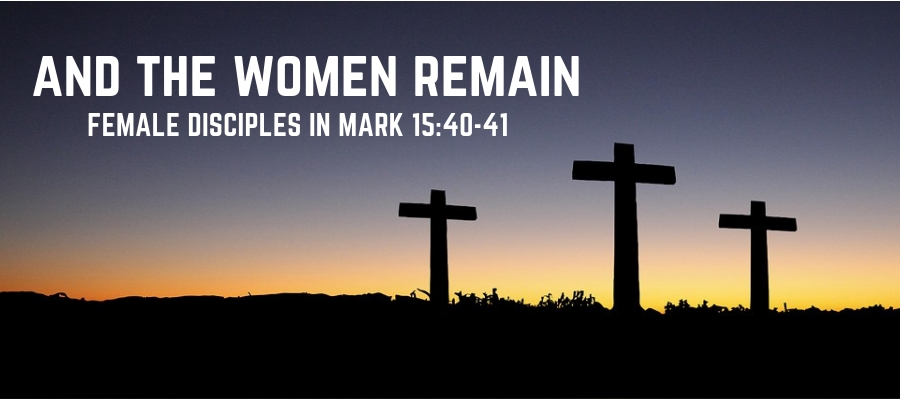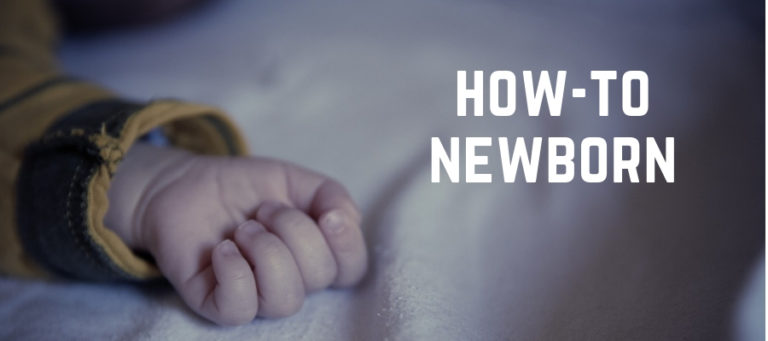
And the Women Remain: Female Disciples in Mark 15:40-41
by Lisa Cotter, posted in Femininity
“And so the order is inverted, for the Jew kills, and the Gentile confesses; the disciples fly, and the women remain.”[1] – Theophylact
The hour had finally come. Everything Jesus was attempting to convey to His followers came down to one defining moment, His suffering and death on the cross. Rather than remaining by His side as many promised, everyone flees. Everyone, that is, but a faithful band of women. The women remain. In the midst of His pain and suffering, they remain. As they question and wonder, they remain, and in doing so, they prove that they are true disciples.
15:40a There were also women looking on from a distance.
At the tail end of Mark’s gospel, there is a shift in the supporting characters of the account’s plotline. In chapters 1-14, Mark writes exclusively on the discipleship of Jesus’ male followers.[2] Now, at the end of Mark 14, he no longer speaks of their actions until after the resurrection. Instead, for the first time,[3] in Mark 15:40, he turns his attention to the women who have drawn near to Jesus throughout His ministry and Mark highlights how they accompanied Jesus through His death, burial, and resurrection.
Why the sudden shift? In general, the gospel of Mark is accepted as the eyewitness account of the apostle Peter.[4] However, Peter was not present at the crucifixion or burial of Jesus and thus could not share a firsthand account of the events. Rather, he had to rely on the witness of these women, who did not flee but remained.
To emphasize the women’s credibility as eyewitnesses to the events, seven times Mark uses verbs of observation to describe their state of attention during Jesus’ death, burial, and resurrection. The first of these verbs is in Mark 14:40 as the women are “looking on.” Here the Greek word for looking is theóreó, which means to observe something with sustained attention.[5] Mark desires to emphasize that the women were not just passersby at Calvary, but they were watching intently with considerable attention to detail regarding all that was happening. Thus, in an attempt to satisfy a key ancient historiography concern for eyewitnesses[6], and to fulfill the multiple witness requirement of Deuteronomy (Deut 19:15), Mark assures that his eyewitnesses were indeed watching.
In all four gospel accounts, there is a record of the presence of women at the cross (Matt 27:55; Mark 15:40; Luke 23:49; John 19:25). Additionally, in each of the synoptic accounts, the detail of the women watching “from a distance” is noted. This observing from a distance harkens back to Psalm 38 where the psalmist recounts that in the midst of suffering, “Friends and companions shun my disease; my neighbors stand far off” (Ps 38:12). Like the friends and companions of the psalmist, rather than drawing near to the Lord, the women keep their distance.
Additionally, in this passage, the Greek word for “a distance” or “afar” is makrothen. This word is the same Greek word that was used one chapter earlier to describe Peter’s tentative following of Jesus into the High Priest’s palace (Mark 14:54). Here we see the psalmist’s friends, the women, and Peter are all alike in that rather than drawing near to the one who is suffering they observe from “afar.”
To account for this distance, some scholars propose that this seemingly insignificant detail points to the fallibility of the women.[7][8] While they are better off than the male disciples who have fled, the women are still hesitant in their discipleship as they run to the cross, but watch from a distance with seeming trepidation.
15:40b Among them were Mary Magdalene,
After stating the presence of women at Calvary, Mark gives names to three of the key witnesses. In doing so, he adds to the credibility of his eyewitnesses, whom he has chosen in part because they were likely well known in the early Christian community[9]. In naming them, he gives an ancient reader the opportunity to personally verify their accounts through them or someone who knew them.
To begin his list of witnesses Mark introduces Mary Magdalene. Because Mary was such a common name during the time of Christ, Mark and the other gospel writers distinguish this Mary from the others by adding to her name her town of origin, Magdala, which is located in the region of Galilee. Up until this moment, Mark gives no previous mention of Mary Magdalene or her connection with Jesus. However, the gospels of Luke (8:2) and Mark (16:9) detail that Mary was a follower of Jesus whom He cured of seven demons. Later in the resurrection accounts, it is made known that, perhaps as a reward for her faithfulness in witnessing the mystery of the cross, Mary Magdalene was the first to witness the resurrected Christ.
15:40b Mary the mother of the younger James and of Joses,
Mary the mother of the younger James and of Joses is the next eyewitness to be mentioned by name in Mark’s gospel. Again, Mark runs into the issue of needing to clarify which exact Mary he is referencing to avoid confusion.
The introduction of this Mary’s sons, James and Joses, is not the first time these brothers are accounted for in Mark’s gospel. Earlier in Mark 6:3, when Jesus returns to his hometown of Nazareth, Mark introduces them as “brothers” of Jesus. The use of the term “brothers” here in no way jeopardizes the perpetual virginity of Jesus’ mother, Mary. In the ancient world “brother” was a term that was used for either a sibling, blood relative, or relationship bound by covenant and thus it is entirely plausible that these “brothers” were simply of some form of familial relation to Jesus.[10] For this reason, while the exact relationship between Mary the mother of James and Joses is not known clearly, many scholars agree that they are in some way blood relatives of Jesus, perhaps their mother Mary is even Mary, the wife of Clophas who is present at Calvary in John’s Gospel[11] (John 19:25).
Finally, the adverb “younger” which is attached to James is given as a distinction between this James and James the Apostle, who was a son of Zebedee and the plausible son of the next named woman, Salome.
15:40b and Salome.
The final woman Mark identifies as an eyewitness to the crucifixion of Jesus is Salome, whose unique name requires no further explanation. Salome is speculated to be the wife of Zebedee and mother of the apostles James and John. The primary grounds for this connection comes from the gospel of Matthew. In his gospel, Matthew lists three eyewitnesses: Mary Magdalene, Mary the mother of James and Joseph (an alternative form of Joses) and “the mother of the sons of Zebedee” (Matt 27:56). According to many scholars, including the early Church Father Origen, Salome and the mother of the sons of Zebedee are the same woman.[12]
Finally, the reference to these three women begins an inclusio which is filled with a period of waiting for the resurrection. The mention of these women by name comes right after the death of Jesus in Mark 15:37 and then they are mentioned together again in Mark 16:1, right before the resurrection, thus bookending the time between Jesus’ death and resurrection.
15:41a These women had followed Him when He was in Galilee and ministered to Him.
After establishing the historical credibility of his three key eyewitnesses to the crucifixion, Mark turns his attention to establishing their personal credibility as followers of and ministers to Christ. These women did not first encounter Jesus on the road to Calvary but rather had previously experienced a life-transforming encounter with Jesus and knew Him intimately.
To begin, Mark notes that the women have been following Jesus since His time in Galilee. Making this geographical distinction draws attention to the exact time in which the women began to follow Jesus, which turns out to be, since the beginning. Immediately after Jesus’ baptism and temptation in the desert, “Jesus came to Galilee proclaiming the Gospel of God” (Mark 1:14). Here one can see that while Mark does not mention the presence of these faithful women until after Jesus’ death, they were there with Him all along.[13]
Not only were these women with Him, but Mark clarifies that they “followed” Him and “ministered” to Him. The interpretation of both of these verbs is clear discipleship language that indicates that these women were true disciples of Christ.[14]
First, here the word choice for “followed” is akoloutheó in Greek. It is the same “follow” that is used to describe when Jesus called the apostles to follow him. Peter and Andrew left their nets and akoloutheó (followed) Jesus in Matthew 4:20. Likewise, James and John abandoned their ship and akoloutheó (followed) Him in Luke 5:11. In using the same form of “followed” Mark shows that the women too are called to follow after Christ as disciples.
Secondly, in this verse the word choice for “ministered to” is the Greek word diakoneó, which means “serve” or “ministered to.” This form of “ministered to” is the same Greek verb used to describe Jesus’ mission of service.[15] In Mark 10:43 Jesus states, “For the Son of Man did not come to be served but to serve (diakoneó).” In following Jesus’ model, the women who were being served by Jesus, in turn, served Him and while He provided for them spiritually, they provided for Him materially.
The material service the women provided likely included tasks such as “preparing meals, washing clothes, and other humble acts of service for Jesus and the disciples.”[16] However, their ministry to Him indeed would not have stopped at menial, domestic chores. In addition to material support, the women would have provided Jesus with friendship and moral support, which is evident in their accompanying Him on the way of the cross. When all others had abandoned Him, the presence of His faithful, female followers would have been the only emotional support extended to Him during His passion.
As demonstrated, Mary Magdalena, Mary the Mother of James and Joses, and Salome rise as prominent supporting characters just as His male disciples fade out of the gospel storyline. These three women were with Jesus from the beginning of His ministry and can be seen as a sort of inner circle of female disciples, which some scholars have likened to Peter, James, and John.[17] While Mark does not mention them until the very end, once he does, they are referenced at each major milestone of the conclusion of his gospel: Jesus’ death (Mark 15:40), burial (Mark 15:47) (however, Salome is omitted here), and resurrection (Mark 16:1).
Additionally, in the gospel of John, Mary Magdalan and Mary the wife of Clophas, who has already been established as possibly being Mary the mother of the younger James and Joses, have moved from their positions watching from afar to standing at the foot of the cross. They are there with Jesus’ mother Mary and John, who is the only male apostle brave enough to draw near to the cross. To be so close to Jesus at the moment of His agony and passing would require a level of love and intimacy that could overcome the strongest of fears.
Finally, like Peter, James, and John these women are not the only followers of Jesus, as while Jesus made His way to Jerusalem, the female disciple community grew, as Mark points out in the second half of verse 41.
15:41b There were also many other women who had come up with Him to Jerusalem
After establishing historical and personal credibility for Mark’s key eyewitnesses, he makes it clear that these women were not the only women who had given up everything to follow Jesus. Like Mary, Mary, and Salome, “many other women” were following Jesus, evidently traveling great distances to accompany Him all the way to Jerusalem. They too would have been like their male counterparts who had left behind their previous life to follow after the One who had shown them the path to eternal life.
For a reader of the gospel of Mark, this sudden revelation of Jesus’ many female followers would come as a surprise given his silence on women for the majority of his account. This surprise would come partly because the general absence of women would have been in line with the treatment of women in the ancient Israelite world. In the time of Jesus, women were seen as the inferior sex in a patriarchal society. Largely, women kept to domestic duties, and the separation of the sexes was given great care in an effort to maintain purity.[18]
While this entourage of female disciples would come as a surprise to some, it is consistent with Jesus’ countercultural approach to women as seen in the gospels. Over and over again Jesus speaks to women in public (John 4:27; 8:10-11), praises women (Mark 12:41-44), and pays attention to their needs (Luke 13:12; Matt 9:22). All of these actions would have been seen as out of the ordinary, if not downright questionable.[19] For Jesus, He did not see inferiority, He saw beloved sisters who were capable of the great call to discipleship.
Conclusion
In two short verses, Mark upturns all previous assumptions about women and discipleship showing that the call to follow Jesus is not just for the elite, not just for Jews, not just for men, but for all. He does not purport that the females who followed Jesus were perfect, after all, He reminds us that with some hesitation they watched “from afar,” but he does show that they too were doing their best to follow our Lord. Rather than discourage us, this note of imperfection can be encouraging as one considers his or her own discipleship that, at times, may be hesitant. By remaining faithful in following the Lord, especially in times of trial and crosses, the reward of the resurrection is awaiting.
*This post is my term paper from a class I took at the Augustine Institute in the spring of 2018.
Footnotes
[1] St. Thomas Aquinas, Catena Aurea: Commentary on the Four Gospels Collected out of the Work of the Fathers, accessed April 12, 2018, https://www.ecatholic2000.com/catena/untitled-55.shtml#_Toc384506955.
[2] Richard Bauckham, Jesus and the Eyewitnesses: The Gospels as Eyewitness Testimony (Grand Rapids: William B. Eerdmans Publishing Company, 2017), 520.
[3] Mary Healy, The Gospel of Mark: Catholic Commentary on Sacred Scripture (Grand Rapids: Baker Academic, 2008), 323.
[4] Healy, The Gospel of Mark, 18-19.
[5] Bauckham, Jesus and the Eyewitnesses, 522.
[6] Bauckham, Jesus and the Eyewitnesses, 523.
[7] Healy, The Gospel of Mark, 324.
[8] Elizabeth Struthers Malbon, In the Company of Jesus: Characters in Mark’s Gospel (Louisville: Westminister John Knox Press, 2000), 62.
[9] Healy, The Gospel of Mark, 324.
[10] Scott Hahn and Curtis Mitch, The Ignatius Catholic Study Bible: New Testament (San Francisco: Ignatius Press, 2010), 29-30.
[11] Healy, The Gospel of Mark, 324.
[12] Aquinas, “Catena Aurea”.
[13] Malbon, In the Company of Jesus, 57.
[14] Winsome Munro, “Women Disciples in Mark?,” The Catholic Biblical Quarterly 44, no. 2 (April 1982): 225-24, http://www.jstor.org/stable/43709754.
[15] Healy, The Gospel of Mark, 324.
[16] Healy, The Gospel of Mark, 324.
[17] Malbon, In the Company of Jesus, 58.
[18] James B. Hurley, Man and Woman in Biblical Perspective (Grand Rapids: Zondervan, 1981), 73.
[19] When the apostles come upon Jesus publically speaking to the Samaritan woman, they are “amazed” at His actions (John 4:27).
Bibliography
Aquinas, St. Thomas. Catena Aurea: Commentary on the Four Gospels Collected out of the Work of the Fathers. (Vol. 2). Accessed April 12, 2018. https://www.ecatholic2000.com/catena/untitled-55.shtml#_Toc384506955
Bauckham, Richard. Jesus and the Eyewitnesses: The Gospels as Eyewitness Testimony (2nd Edition). Grand Rapids: William B. Eerdmans Publishing Company, 2017.
Blayney, B., Scott, T., and Torrey, R.A. with Canne, J., Browne. The Treasury of Scripture Knowledge (Vol. 2). London: Samuel Bagster and Sons, 1983.
Hahn, Scott., and Mitch, Curtis. The Ignatius Catholic Study Bible: New Testament (2nd Edition). San Francisco: Ignatius Press, 2010.
Healy, Mary. The Gospel of Mark: Catholic Commentary on Sacred Scripture. Grand Rapids: Baker Academic, 2008.
Hurley, James B. Man and Woman in Biblical Perspective. Grand Rapids: Zondervan, 1981.
Malbon, Elizabeth Struthers. In the Company of Jesus: Characters in Mark’s Gospel. Louisville: Westminister John Knox Press, 2000.
Munro, Winsome. “Women Disciples in Mark?.” The Catholic Biblical Quarterly 44, no. 2 (April 1982): 225-24. http://www.jstor.org/stable/43709754


